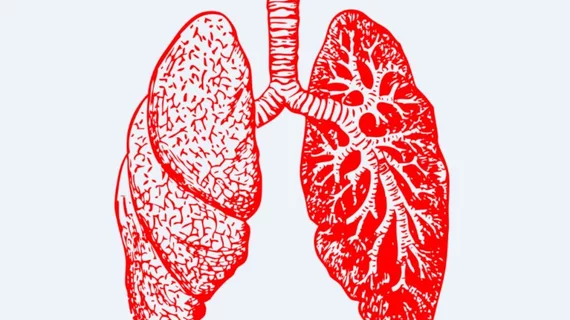Radiologists across specialized, non-specialized centers interpret lung CTs with similar accuracy
Radiologists working in specialized cancer centers exhibit the same efficacy in interpreting lung CTs as their counterparts working in non-specialized institutions, researchers reported in Clinical Radiology this month, suggesting large-scale lung screening efforts are likely diagnostically sound.
B. Al Mohammad, of the Department of Medical Imaging and Radiation Sciences at the University of Sydney in New South Wales, Australia, and colleagues said that since the release of the U.S. National Lung Screening Trial in 2011, physicians have been recommending annual CTs for lung cancer screening, especially in high-risk populations. Still, clinicians’ variability in how they interpret those exams could threaten the process.
“Lung cancer detection is considered one of the most difficult radiological tasks, with approximately 300 axial images contained within a single CT examination of very complex lung parenchyma surrounding the nodules,” the authors wrote. “Previous literature has shown high variability in sensitivity for radiologists when detecting lung nodules in CT images, ranging from 0.30 to 0.97.”
That wide range of variability is concerning, Mohammad and co-authors said. And while some highly developed regions such as the U.S. and China are already implementing lung cancer screening programs on a national scale, it’s important countries assess the diagnostic ability of their radiologic workforce before forging ahead with similar plans.
Mohammad et al. did that with their study of 30 radiologists in Jordan, a Middle-Eastern hub of around 6.5 million. Jordan has some established cancer screening programs, the authors said, including one for breast cancer, but no comparable programs for lung cancer. Radiologists were presented with 60 chest CTs, half of which were cancer-free and half of which exhibited surgically or biopsy-proven lung cancer. All cancer cases were validated by a group of outside experts.
The researchers measured radiologists’ performance by calculating their sensitivity, location sensitivity, specificity and area under the receiver operating characteristic curve (AUC). They found that readers had a mean sensitivity of 0.749, sensitivity at fixed specificity (0.794) of 0.744, location sensitivity of 0.666, specificity of 0.81 and AUC of 0.846—all numbers comparable to previous studies.
Unique to this research, though, was the comparison of radiologist performance between specialized and non-specialized medical centers. Mohammad and colleagues said despite the stratification, sensitivity, specificity and AUC statistics remained close between the groups.
“Although the preliminary analysis did not show significant differences between the two groups, 95 percent confidence intervals were too wide to conclude that the groups were clinically similar with respect to sensitivity, location sensitivity and specificity,” the authors wrote. “Mean sensitivity was 8 percentage points higher in the specialized center (0.80 compared to 0.719), with most of the confidence interval for the difference (specialized minus non-specialized) being to the right of zero. These results suggest that a significant difference might be found with more precise estimates from a larger study.”
Mohammad et al. said their study has some limitations, including the fact that readers weren’t provided any patient medical history that might have impacted the interpretation of CTs. But it does provide the data needed for sizing a future large-scale study of the same subject.
“The results of the present study show that radiologists in Jordan have a similar cancer detection performance as demonstrated by the AUC and a higher sensitivity to that demonstrated in other studies,” the researchers wrote. “Furthermore, the initial findings suggest that it may be feasible to perform lung cancer screening in multiple non-specialized locations.”

